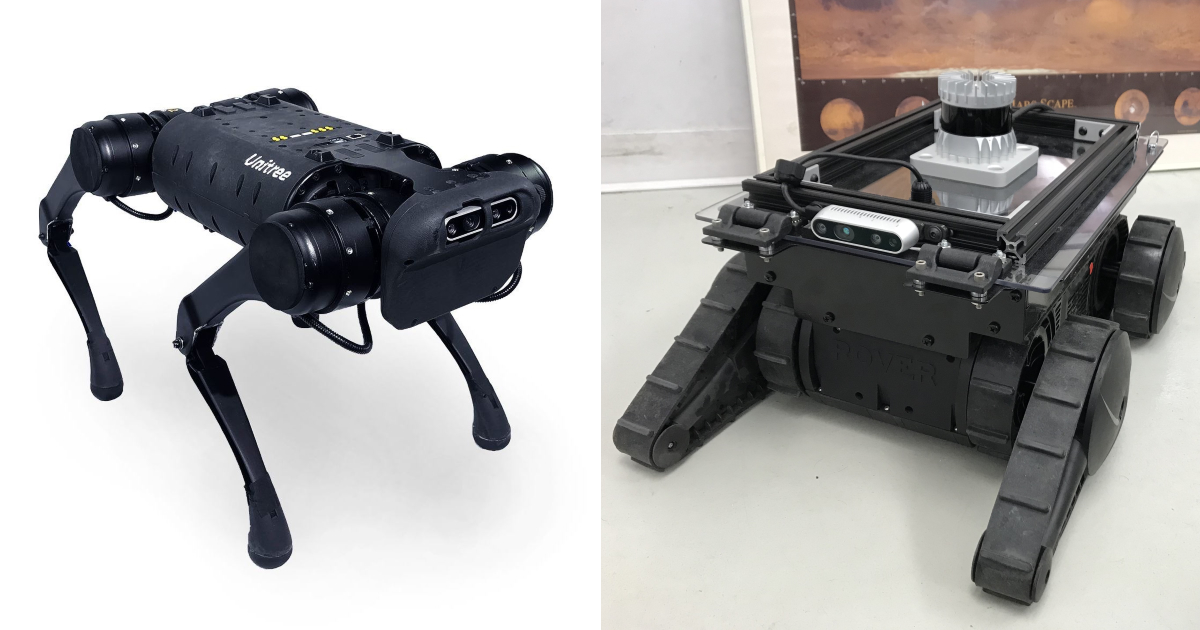Nouvelles
Landing in Switzerland – before even the Moon or Mars!
If all goes as planned, Professor Giovanni Beltrame’s team (Department of Computer and Software Engineering) will travel to Lucerne, Switzerland in July 2021 - accompanied by his three robot rovers and a robot dog. The group’s mission? Map terrain totally unknown to them.

Professor Giovanni Beltrame’s team and equipment will test their mapping capabilities, using a robot dog and three rovers like those shown in this photo. (Photos: Unitree Robotics; Pr Giovanni Beltrame’s team)
The Polytechnique Montréal team is one of 13 organizations selected by the Swiss Space Center and ESA_Lab (European Space Agency), to join the 2021 IGLUNA cohort, a platform that oversees the development of space technologies. More than 200 university students from nine countries are taking part in the project.
For this, its third edition, IGLUNA will focus mainly on the development of exploration technologies, but will also focus on survival approaches – such as food and oxygen production, and the construction of living quarters and installation of electrical systems. To accomplish this multifaceted task, the organization will offer participants an environment that reproduces exploration conditions encountered on the Moon, our closest natural satellite - and the famous Red Planet Mars.
Selected teams reached an important milestone in recent weeks by each presenting their concepts to an expert committee. They are now preparing for an interim meeting scheduled for March 2021, and then for final-stage testing, set to take place next summer.
Each group will then deploy their equipment and expertise on the heights of Mt. Pilatus, located on the outskirts of the city of Lucerne. Participants will use remote communication from the Swiss Museum of Transport (also in Lucerne) to control their equipment and instruments.
With its steep, rocky terrain and harsh weather conditions, the mountainous site partially recreates exploration conditions of Lunar or Martian terrain. Adding to the realism of the July ‘space mission,’ an artificial communications delay between the terrain and the control room is planned.
Three rovers and a robot dog
For the July event, the MIST Lab (which stands for: Making Innovative Space Technology) that Professor Beltrame heads, will dispatch a fleet of commercial robots armed with 3D cameras and lidars.
The latter tools will produce an accurate map of the location they explore, collaborating throughout the process with the computer platform created by the Polytechnique Montréal lab.
“The goal is to demonstrate that robots are capable of working in semi-autonomous exploration. Before establishing a colony on the Moon or Mars, this is an absolutely crucial step,” mentions the researcher.
The future-focused professor also notes that using a fleet of robots for this type of mission not only enables you to work faster, but also with more precision. “With several robots, we can collect a series of measurements that enable us to reduce the so-called ‘background noise’ and therefore to produce more accurate maps,” explains Professor Beltrame.
The IGLUNA experience constitutes a golden opportunity for students in the Polytechnique Professor’s research team who will take part in the project. “It enables us to group together several PhD students’ projects, all of whom are working on a similar theme, but it also permits them to access this exceptional experience,” Professor Beltrame indicates.
The researcher and his team started testing their commercial robots only a few short days ago, and anyone present on Polytechnique’s campus might even see those “space-destined” robots roaming around campus buildings over the next few days. The project is being carried out with collaboration from the Canadian Space Agency, who namely provide financial support.
Learn more
Professor Giovanni Beltrame's expertise
MIST Lab website
IGLUNA 2021 website




